I didn’t know Lithuania very well before jetting off on January 22. However, now? I personally think it is an underrated gem of European capitals – and one you should be adding to your interrailing lists.
Vilnius differs from many other cities in Central Europe. It has the romantic elements of cities such as and . But it also has reminders of its Soviet era, with the occasional grey Brutalist block.
The city’s architecture has been described as a “treasure trove,” with its Gothic and Renaissance-style buildings standing as testaments to its rich history and cultural heritage. Many are adorned with elaborate facades and decorative details.
READ MORE:
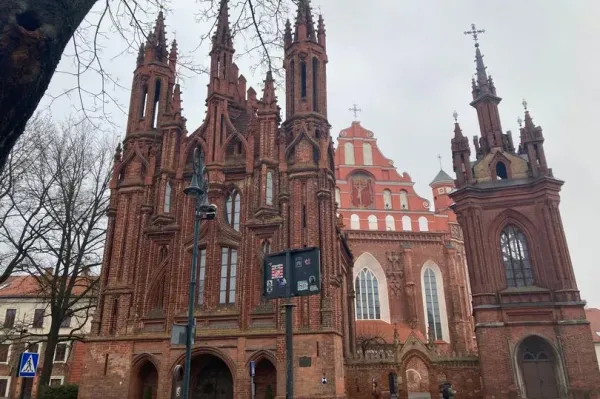
Some of the most impressive examples I saw when pottering with take-away coffee in hand were the Church of St. Anne, Bernadine Church, the Presidential Palace, and the Cathedral Basilica of St. Stanislaus and St. Ladislaus - the city’s main Catholic cathedral and next to Vilnius’ defensive castle.
Old buildings are pretty and make walking around a city enjoyable. This was Vilnius in a nutshell, and not just in its old town but across the entire city. If you aim to get that “Insta” shot wandering down a beautiful, cobbled street – this city is one for you. In 1994, the Vilnius Old Town was included in the UNESCO World Heritage List in recognition of its “universal value and originality”.
I spent my first day in the Baltic nation on a walking city tour organised by . The city isn’t large, and you can easily cover it by walking if you can – so if you are a stroller like I am, you’ll enjoy what it has to offer. I’d say you could cover the city in a day.
Vilnius is one of those places where joining a tour is a must. With a guide, you’ll get a deeper understanding of Vilnius’ distinct character and have an impactful experience that goes beyond what you might discover solo in other European cities. For things to do, if you’re interested in Lithuanian history, you should visit the Palace of the Grand Duke, which I think covered it brilliantly.
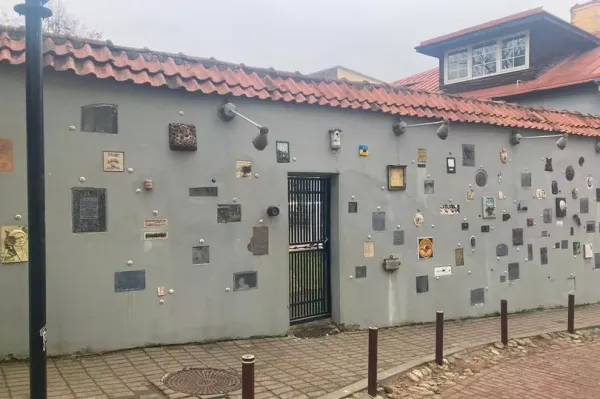
The Palace has many beautiful rooms that have been reconstructed to replicate what they would have looked like in the 15th century, when the palace was the home of the Grand Duchy of Lithuania. Costing just 10 euros, it takes a good few hours, and the highlight was the viewing platform at the top, which gives you a great view of the old town.
Although, for a better one, you should head to Gediminas Tower on the hill next door. It’s a bit of a small trek, but in the daylight, you can see for miles. It’s also completely FREE.
If you want to learn more about the history of day-to-day life, then you should visit the National History Museum. And for all things political, you should head to the House of Signatories - where on February 16, 1918, the Act of Independence of Lithuania was signed.. Both will set you back around six euros.
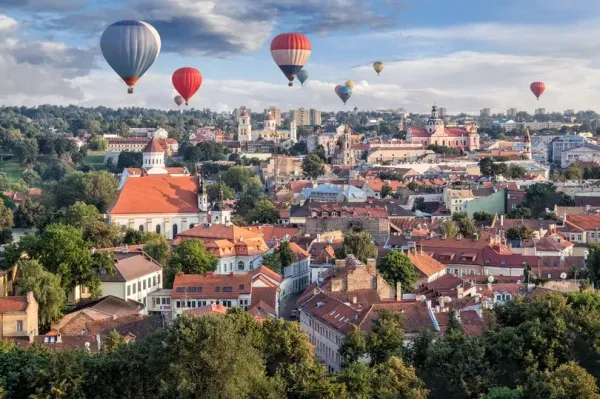
Vilnius is also making a name for itself as a European art hub, and one of its newest museums, MO, is a good spot to hit if you want to check out both modern and traditional Lithuanian art. Overall, it has around 5,000 pieces in its collection - although not all of them are on display.
With an adult ticket costing 16 euros, this is definitely the place for a drizzly afternoon. It’s not big, so you could easily complete it within two hours. The current exhibition - which is on until August - is called “From Within” and focuses on the impact of art on emotional health told by influential Lithuanian artists.
I definitely think I could’ve done another day - so a long weekend - in Vilnius as I felt there was a lot which I wasn’t able to squeeze in.
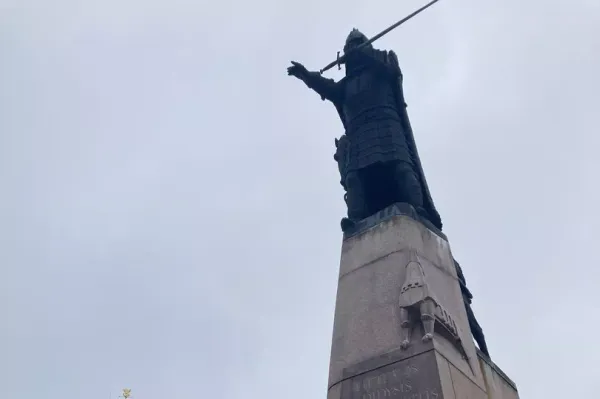
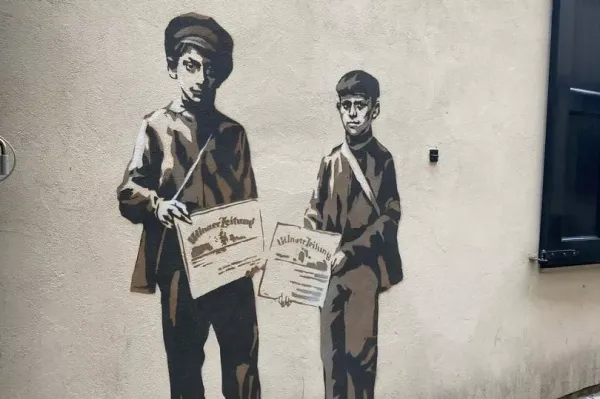
Something that made me anxious about visiting the eastern European city was whether I would be able to enjoy its cuisine. I am vegan and have been for nearly eight years. Overall, the cuisine consists of root vegetables such as potatoes and beetroots, lots of meat, and bread. Its national dish is potato dumplings stuffed with minced meat and soured cream.
However, I was so wrong. On my first night, I went to the traditional Lithuanian restaurant Lokys, in the Jewish quarter. Opening 50 years ago – even though parts of the building date back all the way to the 15th century - the restaurant is one of the oldest family-run establishments in the city, and guests can enjoy dishes dating as far back as Medieval Times.
Although there weren’t many vegan options, there were some, and that was a win. To start, I got a basket of rye bread with beetroot hummus and a pint of lager from the historic Lithuanian Gubernija Brewery - a flavourful drink with more of a pale ale vibe than a standard lager.
My starter was a simple Salad with Bilberry Vinaigrette. Bilberries are small dark blue berries native to Lithuanian forests and are sweet and a little tart. The dish featured salad leaves with peppery rocket, confit and fresh cherry tomatoes, walnuts, strawberries, blueberries, and radishes.
The main part - and the highlight - was the vinaigrette. It had the texture of a balsamic glaze, and its tangy flavour gave the dish an oomph. Meat-eaters who want a little extra can get the salad with smoked fish or beef.
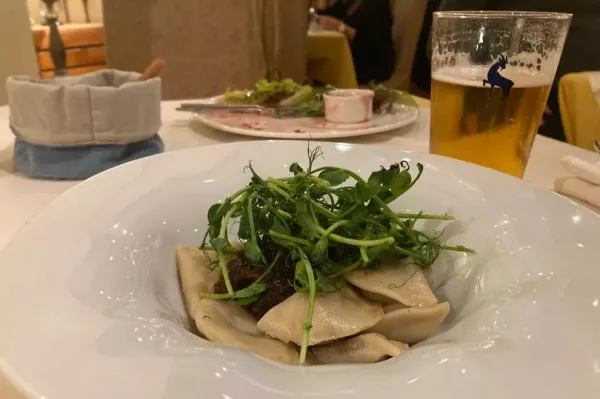
If you fancy a more traditional option, the restaurant offers a “Lithuanian Beer Snack,” which features smoked fish, cheese doughnuts, dried meat, smoked pig ears, and fried rye bread. Another table ordered this, and it was truly a spectacle. For the main, I had homemade Boletus Mushroom Dumplings with tangy onion jam. The dumpling filling was rich and savoury, and the sweetness and acidity of the onion jam cut through it sharply. This dish was simple but delicious.
During my trip, I ate at a range of restaurants that did their own unique take on the Lithuanian cuisine, and all of them were exciting and tasty. So, you’ve got yourself an abundance of options if you decide to visit. Vilnius is also fast becoming a food hub of Europe. Last year, four restaurants were awarded Michelin stars. Although, these can be a bit pricey.
One of my biggest regrets was that I couldn’t find a vegan version of the country's Cold Beet Soup - aka Pink Soup. The dish - which is called šaltibarščiai - is made with beetroots, kefir, and milk and served with quail eggs and boiled potatoes.
I heard the taste is “earthy-yet-refreshing,” and with its luminous pink appearance, it has garnered a bit of social media fanfare. Vilnius also has an entire festival dedicated to it in the summer. You can get yourself a version of the dish in many restaurants, and there are vegan options. Although, in the LoveHip vegan establishment, it sadly wasn’t available that day. But it's all good; it just means another trip in the future.
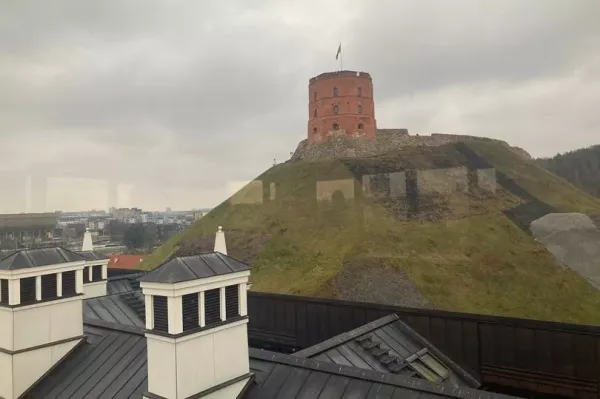
The reason for my trip to the city was for the which celebrates the city’s birthday on January 25.
The reason why it is this date is due to an old Lithuanian legend. According to the tale, a Grand Duke named Gediminas dreamt of an iron wolf on a hill during a hunting trip in Šventaragis valley - which today is near the capital’s Cathedral Square. Taking this dream as a divine sign, Gediminas decided to build the mighty city of Vilnius, which he foresaw as being “the city of iron and famous worldwide, echoing the howls of a hundred wolves.” As part of his plan, the Duke wrote letters to Western Europeans inviting them to join.
The earliest surviving letter mentioning Vilnius is dated January 25, 1323 - so this is now its birthday, and this year, it was celebrating its 702nd. From Friday, January 24 to Sunday, 26, the festival transforms the city into an open-air gallery, with 18 light installations, video projections, and interactive displays exhibited across the city’s Baroque Old Town.

This year’s festival – which is only the seventh time it’s been held – focused on the city’s role as the European Green Capital 2025, as well as its arts and culture. The opening night of the festival was thankfully dry – but it was very cold, with the temperature sitting at around two degrees all day.
I arrived in the city earlier in the week and commented on how quiet it felt. However, as I walked out onto to cobbled street, the contrast was evident. The festival is free to attend, and around 200,000 people head to the city each year to enjoy the festivities.
The atmosphere could only be described as electric, it was absolutely buzzing. Dance music blasted out of a DJ stage which was in the shape of a large green dragon, and every few minutes, a flare blasted out of the dragon’s mouth to the sound of excitable screams from both children and adults. It was so much fun, and you’d find yourself sticking around to join in with the next round of cheers.
One of the festival's standouts for me was the Dreaming Sun by Lithuanian artist Agnė Kišonaitė. The piece was made out of old tennis balls which had been donated by local players, which were used to create a large structure of a sun. The piece reflected the artist’s longing for sunlight during long winter evenings (relatable) and served as a reminder of the beauty of reusing everyday materials.

This structure stood by the Palace of the Grand Dukes of Lithuania, and what was fantastic was that you could see a few different artworks, one of which was the crown light fixtures on top of Gediminas Castle Tower. It shot beams of blue and white, which swirled and twirled in the night sky. I couldn’t help but lose myself in it.
Before I knew it, I had been exploring Vilnius’ illuminated streets for almost three hours, and I could’ve spent a few more hours wandering if it hadn’t been so cold.
During this time, I was mesmerised by the colours and animations that twinkled, glittered, and radiated onto the old buildings. I walked down streets with misty hues of green and pink and saw projections that were the electrical equivalent of watercolours. One of the jazziest installations was the “Echo of Light” by the Latvian group Those Guys Lighting.
Sat outside the presidential palace, it was an experimental audio-visual installation that represented the continuous movement of energy. It was a massive cylinder that you could walk through, and laser beams would shoot out and reflect against mirrors, forming a hypnotic, almost holographic effect. It also used a fog effect which added a little drama to the walk-through.
There were times when I also felt part of the artwork, particularly when I found myself in the middle of a group of women who were wearing flashing headbands and waving light-up wands, the type you would find at a British Panto. The Light festival was scheduled to end around 10pm, but it felt as though the party could go on for hours - and it did.
Light artwork is not new, and the UK has hosted these types of events before. I went to one in my hometown of Bury once. However, the thought behind the pieces was so interesting, and the execution of the artworks was truly a wonder to see.
It’s a special day for the city, and you can see the care and attention that was put into crafting this event. It was a thoroughly enjoyable experience, although, as it was January, It was freezing. So, I recommend getting yourself a hot drink for your wander - or a beer blanket - whatever floats your boat.
Book itnow connects London City Airport and Vilnius. Flights take two hours and fifty minutes and cost around £100.
Contact to : xlf550402@gmail.com
Copyright © boyuanhulian 2020 - 2023. All Right Reserved.